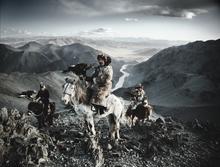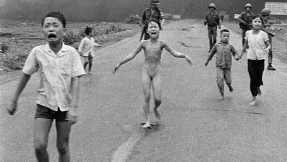Photography: Arts Window to the World

The 18th century saw the emergence of photography, and with that, a huge growth in the breadth of content in the art sphere. Now it is possible to document life instead of interpret it – to show things for what they really are and offer people a wider, more available view of the world, free from the boundaries of artistic capability.
Whilst photography is classed as an artistic medium, many photographers who document the world don’t fall into the category of artists. Photographers range from photojournalists through to editorial photographers, each having a distinctive style and way of showing the world through their lens. These stylistic differences are also in paintings and sculptures alike, however these themselves are interpretive, whereas photographs offer true and real content manipulated or presented in a certain way by the photographer.
People like Jimmy Nelson are an example of how people who don’t intend to be an artist produce the most revered shots. His project Before They Pass Away follows his nomadic journey around the world discovering lost tribes, educating the public about these special people that will one day disappear from the world forever.He has traveled from China through to Africa, New Zealand to South America, all in his mission to find these people and share their story with the world, and by doing so he has created some of the most stunning photographs.
They are beautifully lit, spectacularly honest and full of wonder. His camera is so specialised that it grabs every inch of detail for the portraits of these unusual people, whilst usually having a spectacular back drop of some of the most beautiful landscapes in the world. They could quite easily be put into an exhibition (one that moved from continent to continent would be the perfect way to curate such a show) yet they aren’t classically produced for artistic purposes.
Before They Pass Away has been condensed down into a book, full of these amazing photos and information about the tribes involved. Without Jimmy Nelson conducting this lifelong project, we would be ignorant to the types of people that share this planet with us. Globalisation has allowed us to forget the people that live at one with the earth. Nelson’s project is not only an amazing visual pleasure, but an historical record that has opened our eyes.
Charles Saatchi has also released a book named The Naked Eye which brings together some amazing, non-photoshopped images, once again showing the beauty of the world, but this time with artistic intention. Each photograph is given a background story, so the book is as informative as it is beautiful. An amusing yet astonishing set of photos includes the documentation of when an unsedated crocodile bit off the hand of Chang Pu-yo. Documentation of events like this is an important way that photography allows us to see the world, and whilst Charles Saatchi documents this in a humorous and attractive way, photojournalism plays a bigger part.
Without photography, we wouldn’t feel the momentousness of events like wars or poverty. Nick Ut’s Napalm Girl won the Pulitzer Prize in 1973 for Spot News Photography, and whilst having no artistic intention, it has become a revered piece of photography for its brutal honesty and empathy it creates.Photojournalism is probably the most inspiring and emotional type of photography, and this is our window to the world. The use of photography in campaigns for child abuse, animal cruelty and poverty strike an emotional connection with us, clearly demonstrating the persuasive and connective power of photos.

Napalm Girl was an international talking point because it showed the world the hideous tactics that were being used against innocent people in Vietnam, and it was followed by a reactionary string of protests and demonstrations throughout America. Having a photo with a face full of emotion speaks more words than an article ever could. As humans, we are programmed to empathise with others, to feel their pain through their expressions, and this is why photography has been so influential. Without photojournalism, we would be largely unaware of what is going on around us, and what people, in these places we will probably never go, are feeling – written word is only so valid.
Photography manages to capture one specific moment in time that can never be repeated. Whilst you may sit with someone for 3 hours, their face will go through a series of unnoticed emotions and expressions and it takes only one photo to completely change the perception of a moment. This is a key reason why photography is so emotive – it captures a moment, emotion, feeling or a beauty in a way that no memory or word ever can. It allows us to see deeper into the person than anything else.
We need only look at the National Geographic photography page, or coffee table books from David Attenborough’s Blue or Frozen Planet to fully understand not only the beauty of photography, but it’s importance. Much like Jimmy Nelson, National Geographic aims to document and preserve these images in an historical way. For the future generations, animals like pandas or tigers may not exist, and through these photos, they are frozen in art forever. They will forever be our window back in time.
 There are many arguments that can be bought up against photography’s importance, like its use in propaganda or technological tampering, but in the long run these arguments are limited, and the general importance of photography shines through. Documentation can be beautiful.
There are many arguments that can be bought up against photography’s importance, like its use in propaganda or technological tampering, but in the long run these arguments are limited, and the general importance of photography shines through. Documentation can be beautiful.
What do you think? Leave a comment.











Napalm Girl is a powerful picture that I’ll never forget.
This is a decently written post, but doesn’t add much to the discussion beyond promoting photography on its base.
Photography is definitely not art. In my opinion it’s something way more beautiful and profound.
Someone once asked me if I thought photography was painting with light. I said no, I think painting is photography with paint.
Also, anyone can take a photograph, isn’t that great. Just like anyone can write a song. Not everyone however is the Bealtes.
You’re sending mixed signals here.
Interesting article; I completely agree with you about the power that photography can have. However these days I worry that the impact of photography is becoming lessened – the process of it is a lot quicker, there are countless new photographers making Flickr accounts each day and the result is that we just consume rapidly without taking anything in and glimpse over photographs that could have real impact if looked at closer.
I agree completely that as we are more inundated with images we “consume” them. Photography is important and accessible, but not without discernment and appreciation. This article defends the medium but it’s important to remember that there is a difference between a picture and a photograph.
Solid examples. I think the Iwo Jima photo belongs on this list also, unless you’re thinking non-domestic.
This article makes valid points of the importance of this medium. Too many times I hear people taking photography for granite. I appreciate it’s real portrayal of our universe whereas a painting or other mediums of art are more of a perception than photography. Right below to film, photography is one of the most realistic means to expressing real emotion or feeling.
Photography is truly one of the most powerful mediums that we have to express ourselves and to portray the world that we see around us. I remember visiting the Newseum in Washington, D.C. They were exhibiting the 30 most memorable Pulitzer Prize-winning images. I’ve never stopped so many times to cry and wonder at the beauty, pain, heart-break and reality that was shown in an art exhibit. Most of those photos were intended for use in the news. Intended to only tell a story and to not bias the reader. And yet, I have never had a more profound or emotional experience while looking at images. I would have always agreed with this article, but until having that experience, I would not have been able to fully understand the emotive power of photographs.
This is an interesting article. One thing that might be interesting to address in tandem with the argument already present is that many early photographers were also artists (like Degas or Nadar) who used photography as a new and valid form of art-making, not only as a means to document the true reality of daily life. Photography’s uses has also changed throughout time and so have people’s interpretations of photographs — i.e., a photograph that might once be considered simply documentary in meaning is now considered a work of art and hung on the walls of a museum.
You make interesting points, but this is a rehashing of what fine artists, photographers and art historians and critics have been ruminating for several centuries now.
To argue that photography is the only medium able to capture what the eye truly sees is both wrong and close minded. No still image, painting, drawing or photograph, can fully encompass what the human eye absorbs and how that visual data is interpreted and spliced together in the brain. Photography is both valuable and beautiful at times, but it is not the ultimate purveyor of truth.
The place photography has in the realm of art I think holds true to the purposes of art, to document and to express. Whether we realize it or not any art that is created is documenting what is happening, thoughts that are occurring, or emotions that cannot be avoided. Through photography there are many examples of though out and constructed scenes to convey specific emotions and ideas, while the compulsive photographer who happens to be in the right place at the right time can carry just as much visual weight.
Sorry, but this article is a muddled mess that makes no sense. As one example, Jimmy Nelson’s project was conceived and executed as an art project modeled on the work of Edward Curtis. He applied high art concepts and technology to create stunningly beautiful and technically perfect images of vanishing cultures using an archaic photographic process. He spent hours and hours getting some of those shots, his subjects posing in their finest in sometimes extreme conditions. Like the work of Curtis, it is stunningly beautiful, but it is also mostly artifice. It is art. A photojournalist would be fired for creating portraits like this and passing it off as journalism.
Nit picky detail: photography is invented in the early 1800s, which is the 19th Century. I think you mixed up these two which is very common. It’s very minor; just make sure you check these.